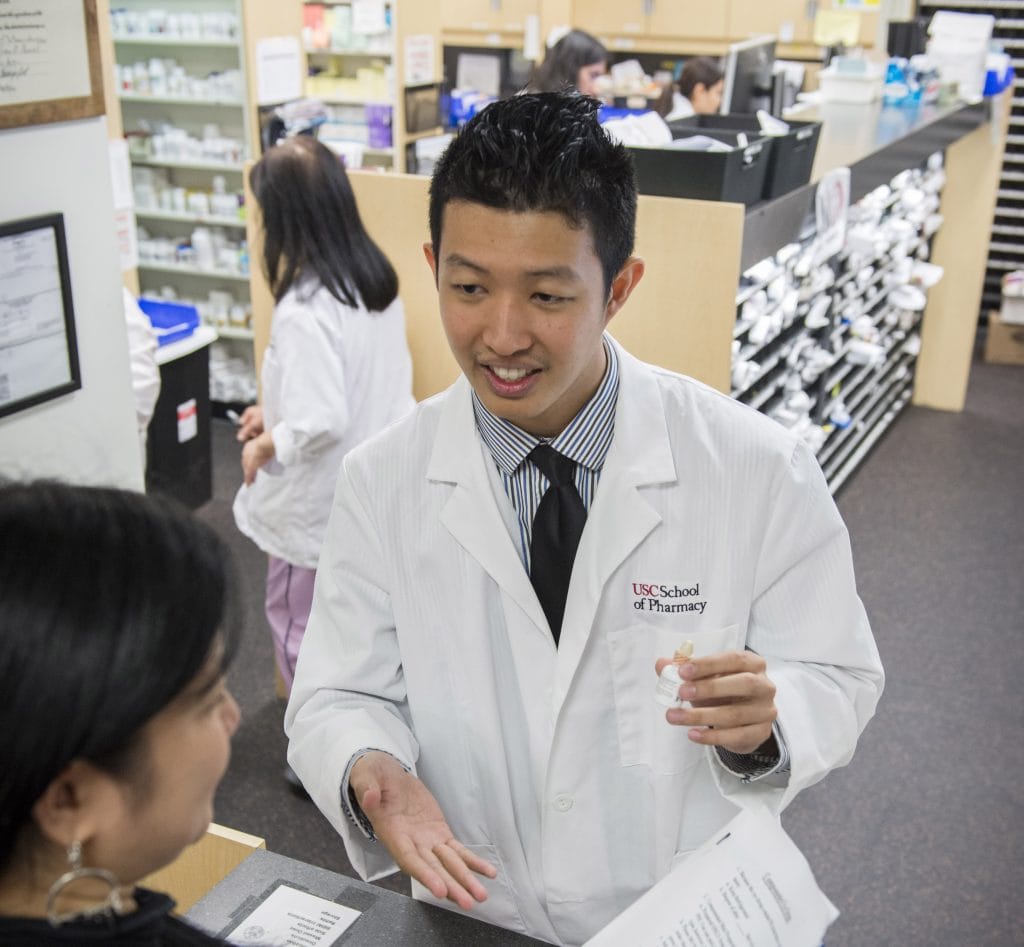Over 70 California healthcare leaders gathered at USC on October 26 for a conference on aligning community pharmacy practice with unmet healthcare needs. The event was sponsored by the USC School of Pharmacy, California Department of Public Health, County of Los Angeles Public Health-Division of Chronic Disease and Injury Prevention, American Heart Association/American Stroke Association and Health Services Advisory Group (HSAG), the Quality Improvement Organization (QIO) for the state.
Addressing the nation’s drive to provide value-based healthcare that improves patient outcomes without increasing costs, participants shared ideas and identified opportunities for collaboration. The aim of the day was specific to finding ways to maximize services of the community pharmacist in today’s healthcare environment.
Steven Chen, PharmD, chair of the Titus Family Department of Clinical Pharmacy at the USC School of Pharmacy, organized the event and charged meeting attendees to consider how the group can work together to ensure that every patient achieves optimal results from medication therapy by sharing needs and resources, and finally making specific requests to actively work together. Attending the invited event were representatives from eight county health departments, the California state health department, quality improvement organizations (QIOs), health associations and community pharmacy.
“Pharmacists are still the best kept secret in healthcare,” Chen said.
Discussions focused on ways to identify strategic goals among participants and to initiate real collaborations. Pharmacists in the room provided examples of how this is possible.
“At Komoto Health, we partner with Medicare Advantage programs on transitions of care,” said Danielle Colayco, PharmD ’08, MS in Pharmaceutical Economics and Policy ’10, Komoto Healthcare Company. “Our partnership with these plans has seen a 28% reduction in hospital readmission.”
Kermit Crawford, formerly the executive vice president and president of pharmacy, health and wellness at Walgreens, laid out the current state of the community pharmacy landscape.
“I believe today that community pharmacy as we know it is at a precipice,” he told the group. “With challenges come huge opportunities. We must develop models that show value.”
Crawford enumerated four factors – consumers, innovations, physicians and regulators – that demand change in today’s environment. He noted that government is now paying about 40% of all healthcare costs and that the fee-for-service model is on the way out. “We have to find new models – the Uber of pharmacy. Uber completely changed the model for its category.”
Alexandria Simpson, California Department of Public Health, picked up on the change theme with a review of the California Wellness Plan’s specific goal that involves community pharmacists in a “systems approach to improving patient and community health.”
Chad Vargas, Health Services Advisory Group (HSAG), the largest Medicare QIO in the country, identified three key areas where pharmacists could play a leading role: care transitions, care coordination and medication safety. Vargas cited research that puts adverse drug events as the leading cause of preventable patient harm and as the primary reason for post-hospital discharge problems. He outlined how community partnerships are formed and indicated where HSAG currently has funding to support these efforts.
Tony Kuo, MD, deputy director of the Division of Chronic Disease and Injury Prevention at the Los Angeles County Department of Public Health, discussed aspects of a CDC chronic disease prevention grant that aims to prevent and control chronic conditions such as hypertension and diabetes. Noting the passage of Senate Bill 493, Kuo said that this is the ideal time to scale up medication therapy management programs.
Senate Bill 493 identifies pharmacists as healthcare providers and creates an advanced practice pharmacist able to fulfill a broader range of clinical tasks, most notably managing medication therapy at the community level for chronic disease patients.
“With 40% of California healthcare expenditures for the six most costly chronic disease states, all which require medications as primary therapy, finding ways to utilize the pharmacist makes sense for everyone,” said Jon Roth, chief executive officer of the California Pharmacists Association.
Chen presented results from a CMS-supported pharmacist intervention project he co-led with AltaMed Health Services clinics which showed the positive impact on patient health outcomes, quality of care and cost. He said that this was the value proposition that pharmacists offer, playing a pivotal role in meeting the important national aims for healthcare. Health departments as well as other organizations represented in the room offered to work with community pharmacists, saying that finding a way to do this effectively stands as one of their key tactics in providing optimal care.
“This all sounds great,” said Sushma Patel, PharmD, a pharmacy owner in Montebello, “But as an independent owner, resources and finances are a big challenge.”
Jon Roth noted that the resources presented during the conference, including a standardized electronic medical record available to pharmacists and all providers, would give community pharmacists the information they need to provide top-quality medication management. Additionally, a system for evaluating patient adherence was also presented. These resources have been slow in coming for pharmacists but they still have a price tag.
“The elephant in the room remains payment for these expanded services,” said Jon Roth. “This is the critical question that has to get resolved.”
Chen pointed out, “The healthcare system is shifting towards a value-based payment system where payment is linked to outcomes. Models already exist where pharmacists are able to sustain the provision of advanced services.”
The meeting ended with collaborative discussion among various potential partnership groups, the goal set forth by Chen at the program start. The USC School of Pharmacy is planning a follow-up to this meeting, with a broader national reach, on February 11 and 12 in Los Angeles.


